
 |
The effect of moisture on the performance of woodwind instruments |
How the player's breath affects woodwind instruments
By Claire Soubeyran, Tim Padfield, Henri Gohin and Peter Spohr
Woodwind instruments absorb water from the player's breath streaming through the bore. This water causes the wood to swell. The swelling is restrained by the dry wood further from the bore surface. The wet wood is easily deformed and does not fully recover its original dimensions when it dries out. Over years of playing the bore shrinks irreversibly and unevenly. The distortion is often apparent at the tenons (joints), where the binding thread or cork also swells against the reinforced socket and exerts an inward pressure on the tenon. Furthermore, the wood of the tenon is thin and the end grain is exposed, so that water uptake is rapid. Permanent distortion causes errors in intonation and deterioration of tone quality. It also complicates the study of ancient instruments. Our study suggests that wrapping with natural fibres make bad joints and that cork is much better, being elastic and slow to absorb water. A deteriorated waterproofing layer can cause trouble by allowing water absorption while impeding drying. Historic instruments that are still played must retain an intact water proofing of the bore. This spoils the historic evidence about the original surface treatment. The curator has to make a decision - to retain the instrument in its condition as it entered the collection or to protect the instrument against further deterioration caused by playing.
The flute is made in four parts. The top joint with the mouth hole is generally stopped with a cork at one end and is approximately cylindrical. The upper middle joint is approximately conical, diminishing from the head joint. The lower middle joint continues this conical taper. The foot joint is also conical but often in the reverse direction expanding towards the end.
The acoustics of the conical instruments is so complicated that the bore is only approximately conical, having subtle changes of profile that are essential to attaining a perfect musical scale over two and a half octaves.
Consequently changes with age and the influence of moisture on the wood are difficult to distinguish from the deliberate operations of the makers reamers.
However, there are some regularities in the departure from the true cone which are found in all flutes. An individual maker with a particular model produced in moderate quantity will often show a consistent pattern of bore modification which taken as a whole provide the correct intonation.
The only old instruments which we can confidently assert retain their original bore dimensions are the glass flutes made by Claude Laurent in Paris in the first half of the nineteenth century.

Although these were made of relatively unstable potash glass, which is prone to surface leaching of alkali in moist conditions, the bore dimension will not change. These flutes have a nearly perfect conical bore in the central joints.

Measurement of the bores of four Laurent glass flutes. The two middle joints are very close to being perfectly conical.
The pitch and the quality of the sound of a woodwind instrument are determined to a large extent by the profile of the bore. Any change in the shape of the bore causes a deterioration in quality and accuracy of the notes. wind instruments have a tendency to shrink with time. This causes the conservation problem of how to minimise this change and the organological problem of how to determine the original dimensions of ancient instruments. The largest deformation is found at the tenons, where the structure is complicated by the use of cork or thread to ensure a close fit. There is often a decorative and reinforcing ring of ivory or metal on the socket.

A selection of transverse flutes ….
A typical joint structure is shown in the next figure.

The pattern of distortion caused by repeated playing is illustrated below by two traces of the internal bore diameter made several years apart.
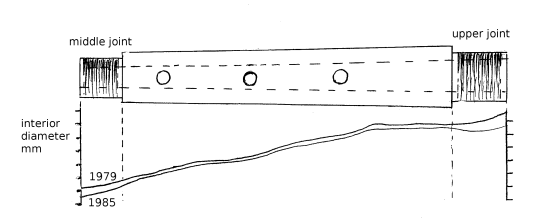
Notice the greater shrinkage at the tenons. The general shrinkage may be due to different ambient relative humidities around the times of the measurements. The larger tenon, closer to the player's mouth, is the more affected.
The jointing material is frequently replaced by the player to maintain a smooth sliding and airtight connection. It is important therefore to investigate the effect of the commonly used jointing materials and to develop materials and methods of application which minimise the deformation of the bore.
This shrinkage seems to be an example of “compression set“, caused by the crushing of the wood cells as the wet wood close to the interior tries to expand against the restraint of the drier wood further towards the outside, the binding threads and the metal or ivory ring. All these materials will tend to resist deformation, causing the wet wood, which is very susceptible to deformation, to collapse. During the drying period this wood partly recovers but a portion of the deformation of the cell walls is retained after drying. Repeated wetting and drying causes a progressive collapse of the wood cells close to the bore of the instrument. The severe shrinking at the very end of the tenons is probably attributable to the easy absorption of water through the end grain of the wood.
The first thing to establish is the temperature and relative humidity, and the approximate moisture flux into the wood during playing.
We measured the temperature profile with a semi-stiff ribbon studded with thermocouples (type K). The ribbon is about 5 mm across.
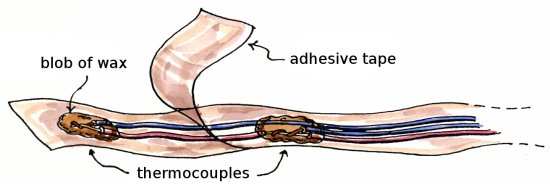
The temperatures at various points along the bore are shown in the next figure.
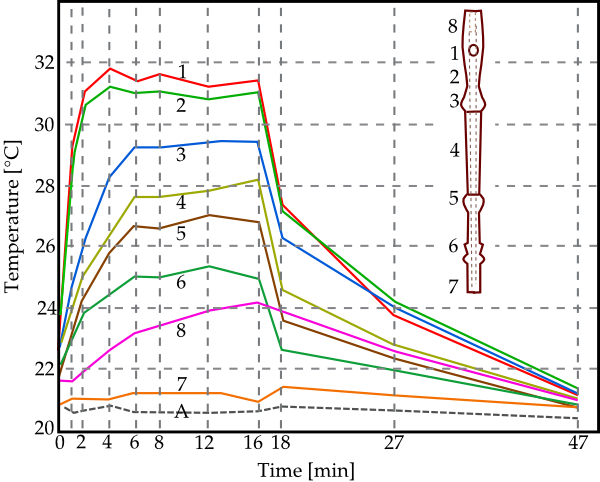
The relative humidity within the instrument was measured with a mini-psychrometer. This consists of two very small thermocouples (type K), one of which is covered with fine cotton thread soaked in water. The two sensors are separated from each other, and from the inner surface of the instrument by a springy polyester shield bent into an S form. This meauring head is fixed to a stainless steel rod. The psychrometer can only measure at one point at a time, unlike the temperature sensor, because the psychrometer adds water vapour to the air stream.
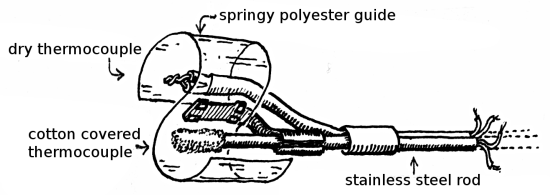
This instrument revealed, as expected, 100% RH established very quickly close to the mouth hole. Condensation started after 30 seconds. However even after eight minutes of playing the RH at the central joint was only 85%.
The final piece of information needed to describe the micro climate is the air flow. This defines the amount of water available to be absorbed into the wood.
The conventional way to measure wind speed in a small tube would be a hot wire anemometer. This measures the temperature of a wire passing a constant current, cooled by the passing air. However, this would be difficult to calibrate in the moist warm air stream, with a varying temperature and RH down the tube. We settled for a more primitive measure: blowing bubbles down a glass tube.

This only works for the few notes played with all finger holes closed. The tube was slightly tilted downwards so the bubbles were almost sliding down of their own accord.
Air flow in litres per minute
| Pitch | end | head joint | |||
| D above middle C | 1.2-2.1 | 2.1-2.5 | |||
| An octave higher | 0.0-1.2 | 1.4-2.8 | |||
| Two octaves higher | - | 8.0-8.5 | |||
—-
These results were confirmed by measuring the water displaced from an immersed flask raised to maintain a neutral pressure in the deformable bag joining the flute to the measuring flask. The air flow for low D was 2 l/m, rising to 2.5 l/m an octave higher.
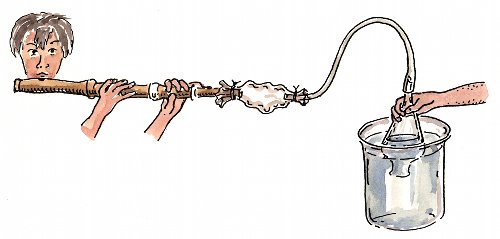
Taking into consideration the varying breath and fingering during a piece of music, one can propose a typical air flow of 2 to 3 l/m.
Since the player's breath is saturated with water at about 35°C, the water vapour flux is about 40 mg per litre of air, corresponding with about 1 ml of water passing through the flute every ten minutes. How much of that is absorbed into the wood is very variable between instruments, depending on the degree of sealing of the surface of the bore.
The components of a flute joint are the wood, the sealing material and sometimes the metal or ivory outer hoop.
The behaviour of the wood is quite complicated, when it is in the form of a cylinder which does not include the centre line of the tree.
An apparatus was constructed to follow the dimensional change of experimental tenons, both with and without the restraint of thread winding and outer sheathing with unstretchable metal.
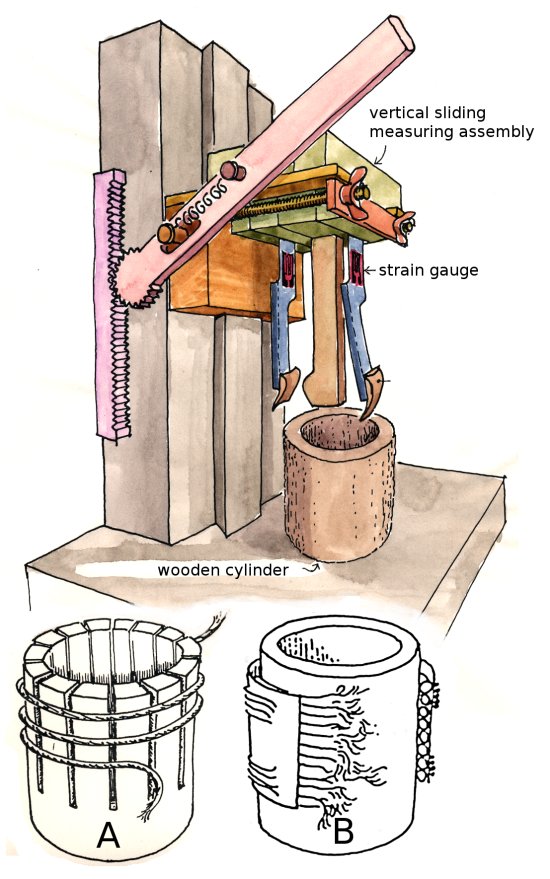
A vertically sliding carriage carries an assembly of a stiff contact point which touches the inside of the bore, and two springy contacts which touch the outside of the tenon and a diametrically opposite point on the inside of the bore. These springs have strain gauges to measure their deflection.
The slotted cylinder A was used to measure the tangential shrinkage of threads. Specimen B shows a complete assembly of wooden cylinder, thread and a flexible but inextensible stainless steel outer skin, tensioned by metal wire.
The picture below shows a close up of the contact system.
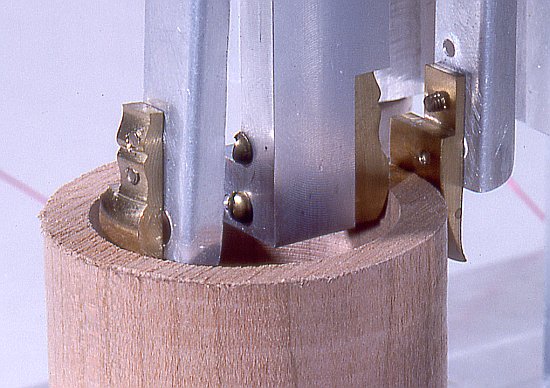
The behaviour of the threads under direct compression was measured with another device which exerted pressure on a flat bundle of thread wrapped around a thin unreactive polyester foil. The deflection of the beam under the load hanging from the stirrup is measured by strain gauges mounted on an aluminium spring which rests with light force on the beam.
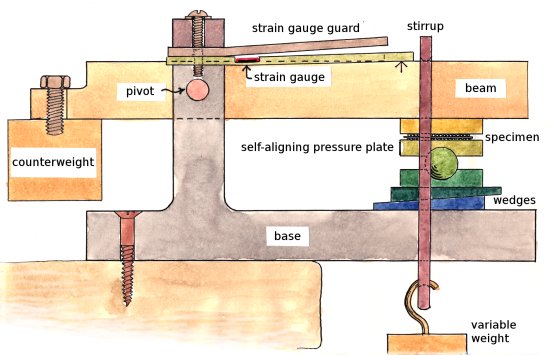
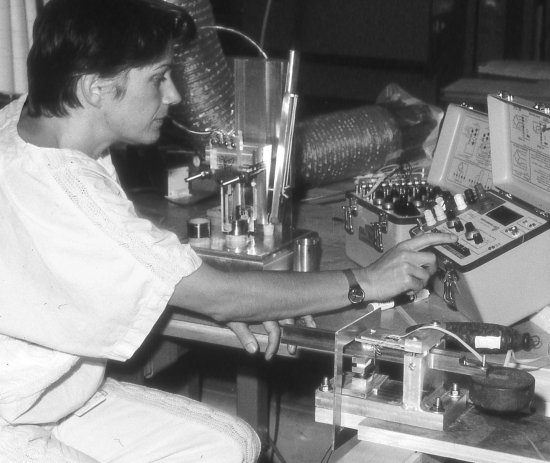
Claire reading the strain gauge signal from the device for measuring tenon size, behind her elbow. The instrument for measuring the swelling of tenon sealing materials is at the bottom right.
A tenon subjected to a short period of wetting followed by air drying swelled in all directions at first. As drying started, the radial dimension reduced while the tangential diameter increased further even during drying.
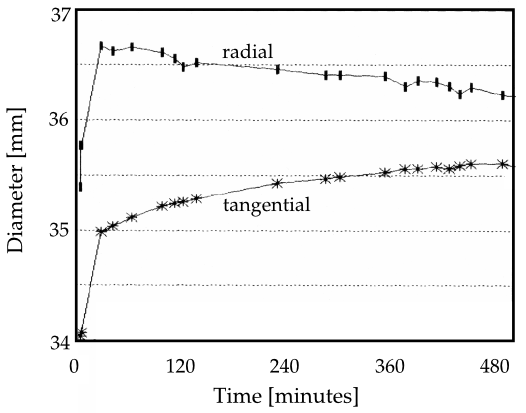
Wooden tenons were submitted to repeated wetting, for two hours, followed by drying for twelve hours. The tenons had an internal diameter 35.2 mm and a wall thickness 2.5 mm. During the wetting phase the tenons became oval, because there was much movement in the tangential direction. After several cycles the oval deformation became permanent as the radial diameter became steadily smaller with each cycle.

Several commonly used binding threads were wound around the wooden tenon. This assembly was then pushed into a plastic cylinder which was unaffected by changing humidity. The assembly was repeatedly soaked in water for six hours, then dried for seven days. A steady shrinkage is evident in the traces for all types of binding.

These tests show the importance of the joint sealing material. There was just 0.5 mm shrinkage with the cork seal, against 1.3 mm with ordinary cotton.
When the tenon shrinks it becomes loose. The player will then probably wrap some more thread around the tenon to fill the gap. The result of doing this is shown in the next diagram. In the first part, the tenon is repeatedly wetted and dried while restrained in a metal band of fixed circumference. In the second part, the band is tightened after each drying (points marked X) to the same snug fit as before the wetting. The increased shrinkage caused by this process is clearly apparent.
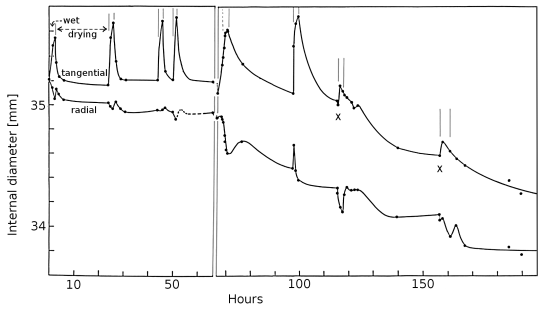
There is evidence that instrument makers made very small and numerous adjustments to the bores of wooden flutes.
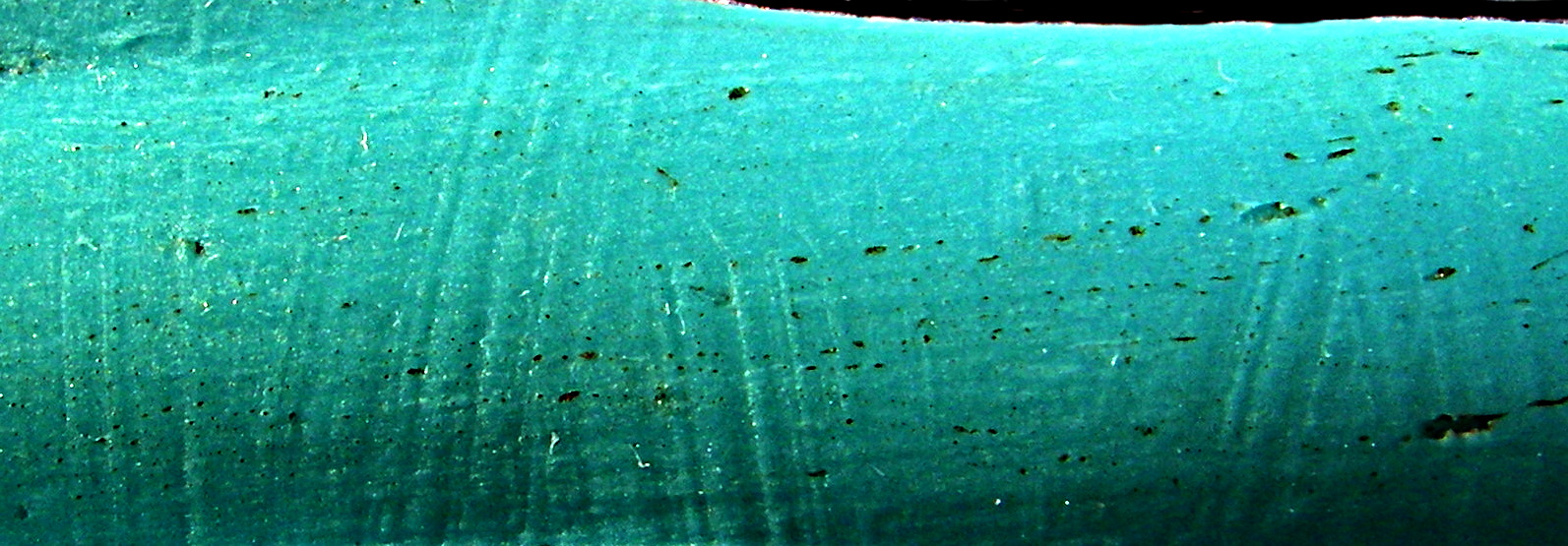
Overlapping scrape marks left by conical augers, revealed by a silicone impression. The view is 20 mm across.
There are many measured bores of ancient instruments. All are much more irregular than the glass flutes described above. Most have a general conical form narrowing increasingly towards the foot. The question is, how well do they preserve the original contours, and how badly do variations influence the intonation of the instrument.
The effect on intonation of obstructing the bore of a recorder (flute a bec) is shown in the next figure.
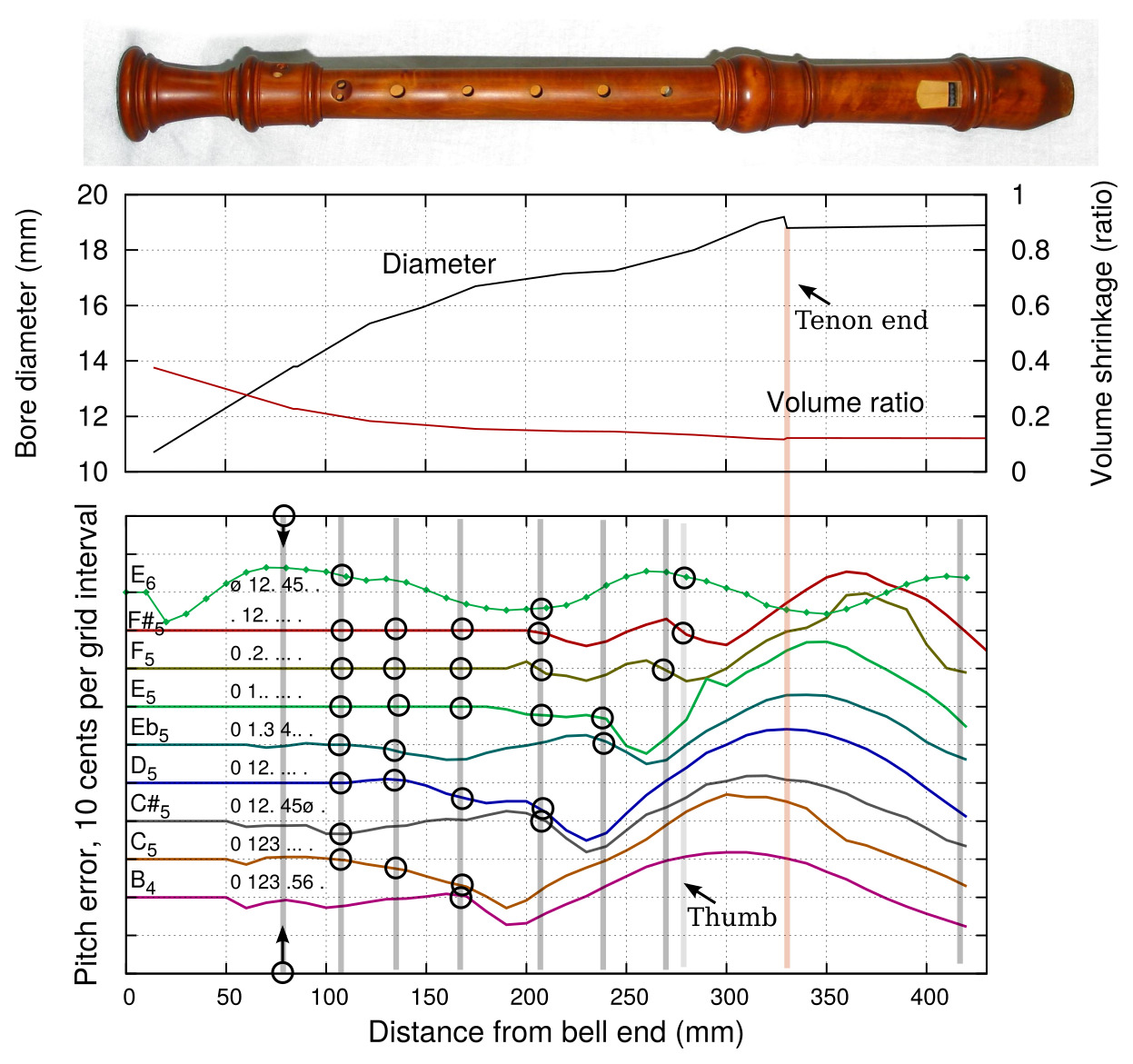
The figure shows the effect of narrowing the bore at different places. A small 'torpedo', suspended on a wire was pushed up the bore while various notes were fingered. The upper graph shows the undisturbed bore diamenter and the proportional shrinkage of the bore volume as the obstruction is moved up towards the lip. The air flow was held constant by using a mechanical device, which also excluded any influence of the temperature and the moisture content of a player's breath. This exclusion of human influence can easily be achieved on a recorder but is not so easy on a transverse flute. However, the taper of the bore and the finger hole pattern is similar in both instruments during the Baroque period.
The main graph shows the error of intonation as the obstruction moves along the tube. The open holes are marked on the tone line. The tone lines for several notes are displaced vertically for clarity. A diversion of the tone line across one vertical grid space represents a ten cent change of pitch.
For the fundamental octave the pattern is clear and consistent. As the narrowing device passes the first open hole from the lip the pitch first drops by about ten cents and then rises again to around ten cents sharp as the obstruction moves further towards the lip. The fall in pitch is caused by the constriction close to the open hole, which moves the antinode further down the tube.
The third harmonic which is used to sound E6, the ornamented line at the top of the graph, shows a different pattern of disturbance which is, towards the lip, in the opposite sense to the E5 an octave below.
The region where variation in the bore volume has the greatest effect on the pitch is also where the top tenon is placed. Shrinkage of the tenon by repeated wetting and drying will therefore influence the intonation of the instrument.
The vulnerability of the joints of woodwind instruments is clearly demonstrated. The causes of damage are mainly two. One is the swelling of the wetted wood fibres at the surface of the bore, which become wet almost immediately, at the top joint but merely reach a high relative humidity in the middle and lower joint. The dry wood further from the air stream resists deformation, so the wet cells collapse irreversibly. When the instrument dries out, the compressed cells shrink back further than their original size. This process can be suppressed, paradoxically, by bringing the entire wooden part slowly to equilibrium with a high relative humidity before playing. This process will swell the entire instrument and tighten the seal. If the player assembles the instrument dry, the joint may at this time be loose, so there is a temptation to add thread which will later swell by water absorption and jam the joint very tight. This will cause the second phenomenon which damages joints - too tight a seal.
The observed shrinkage is greatest at the very end of the tenon where the end grain wood is exposed. These cut cells absorb water very rapidly. In this case the entire thickness of the tenon will expand against the enclosing joint, which remains dry for a long time. Sealing the end of the tenon is therefore an important detail in the maintenance of woodwind instruments. The other lesson from these experiments is that hygroscopic threads, such as cotton and silk, are not a good way to seal the joint. Cork is much better, though fitting it is a specialised job. However, if the instrument is humidified before playing, and kept in a swollen state between playings, as is a wooden boat, the shrinkage will be minimal and the cork seal will therefore last for years without need of supplementing with turns of cotton thread. Unfortunately, a permanently high humidity in the bore will make the instrument susceptible to mould growth, particularly if the bore has been treated with linseed oil. The highest safe RH is around 60%.
These experiments were mostly made at the Conservation Analytical Laboratory of the Smithsonian Institution during 1982. Financial support for Claire Soubeyran came from the French Ministry of Culture.

Claire Soubeyran in West Virginia

This work is licensed under a Creative Commons Attribution-Noncommercial-No Derivative Works 3.0 License.